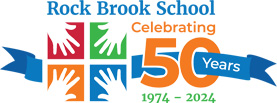A Tragic Loss for RBS
September 9, 2022
FROM THE EXECUTIVE DIRECTOR
Dear Rock Brook Families,

It is with a very heavy heart that I reach out to you with news of the unexpected passing of Rock Brook family member Mrs. Maggie Deeds. There are no details to share with you at this time, but more information will be forthcoming. For now, we ask for your prayers and positive thoughts for Maggie’s family during this very difficult time.
Maggie has been an integral part of Rock Brook School over the past 14 years and her passion for serving our students is unmatched. With great energy, enthusiasm and positivity, she has served as a classroom teacher, a Speech Language Pathologist, Director of Technology, and most recently as our Director of Curriculum and Instruction.
“Miss Maggie” has been part of every intake for every child at Rock Brook over the last 14 years and she clearly set the standard for how to build positive relationships with students and families. Our school crisis team is already gathering resources for you and your family and we will be sharing additional information over the weekend.
Along with our counselor, Mr. Chris, we will have additional staff available to help support students on Monday and throughout the coming weeks. In the meantime, you may find the following links helpful as you process this unexpected news:
https://good-grief.org/
https://www.dougy.org/
https://www.nasponline.org/
I thank you for your support as our Rock Brook School community deals with this devastating loss.
~ Glenn Famous
glenn.famous@rock-brook.org
RBS Family Update
September 11, 2022
FROM THE EXECUTIVE DIRECTOR
Dear Rock Brook Families,
Thank you so much for your outpouring of condolences, remembrances, and offers of support in the wake of the loss of our colleague and friend, Maggie Deeds. This update provides you with information, resource links, and a few ways to support Maggie’s family during this challenging time.
We have provided some links below that you may find helpful as you speak to your child this weekend. From our shared experience base, we know that there is no easy nor singular way to help children understand death, especially when it is sudden and there has been no time to prepare. Each family deals with loss differently and we ask that you share the news of “Miss Maggie’s” death according to your own family, cultural or religious beliefs, and within the context of you knowing your child best.
We will have additional staff available tomorrow to help any child in need, but no class or school “announcements” are planned. As always, we will meet the individual needs of students in the same differentiated manner in which we deal with them on all topics and issues. Should you have specific concerns or questions, please feel free to reach out directly to me or any of the following:
School Counselor – chris.cruz@rock-brook.org
BCBA – maribeth.epstein@rock-brook.org
Supervisor of Instruction – jenie.vargas@rock-brook.org
School Nurses – nurse@rock-brook.org
You may find helpful resources by clicking the links below:
Addressing Grief
Grief and Bereavement Resources Autism Speaks
Additionally, as a way of sharing valued resources and ideas, we have also created a shared Google Doc: Shared RBS Resources for Loss and Grief where you can share titles or links to articles, books, videos, etc., that you have found helpful in the past when dealing with a personal loss or unexpected tragedy. We ask that you simply post the link or the resource you know of and specify whether it is specifically to help students or the adults of our community. Should you have any difficulty posting or accessing the shared doc, please email the information directly to info@rock-brook.org and we will post it for you.
At this time, we have no information in regard to services or arrangements but will forward that to you when received. Many of you have requested contact information or asked how to best support the family. For now, we provide the following options for you:
- Expressions of condolence and sympathy may be mailed or dropped off at Rock Brook School and we will ensure that Maggie’s family receives your expression.
- Similarly, direct financial support for the family may be sent to the school or click the following link for a GoFundMe page that has been set up by Maggie’s friends from the tennis community:
Deeds Family – GoFundMe page
Previously shared resource links:
https://good-grief.org/
https://www.dougy.org/
https://www.nasponline.org/
I thank you for your support as our Rock Brook School community deals with this devastating loss.
~ Glenn Famous
glenn.famous@rock-brook.org
